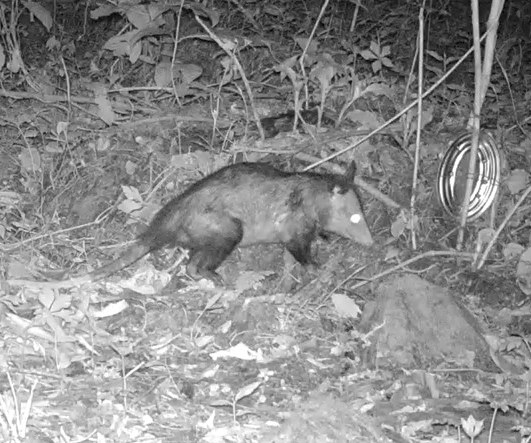Relative abundance and activity patterns of Didelphis marsupialis in a peri-urban area of Medellin, Colombia
Abundancia relativa y patrones de actividad de Didelphis marsupialis en un área periurbana de Medellín, Colombia

Show authors biography
Objective. The relative abundance and activity patterns of the common opossum Didelphis marsupialis were determined in a peri-urban area of Medellín municipality, Antioquia department. Materials and methods. The study was developed in the Remington Veterinary practice at Santa Elena Corregimiento. The data recording was carried out through camera trapping methodology for three months (June-August 2017) with a total effort of 166 days-camera. Results. With a total of 275 independent records, we calculate the relative abundance index (52.88 UNITS). The activity patterns show a first activity peak beginning the night (19:00) and a second one after midnight (3:00), reducing the activity in the sunrise hours. Conclusions. These results present a high relative abundance in comparison to another Colombian localities, besides a population active reproductively. At the same time, they become a tool to support conservation strategies and sensitizing local people about the wildlife of this region.
Article visits 2342 | PDF visits
Downloads
- McKinney, M. Effects of urbanization on species richness: A review of plants and animals. Urban Ecosyst. 2008; 11(2):161-176. doi: 10.1007/s11252-007-0045-4. https://doi.org/10.1007/s11252-007-0045-4
- Marin M, Alvarez F, Giraldo C, Pyrcz T, Uribe S, Vila R. Butterflies of an andean periurban cloud forest in the Aburra valley, Colombia. Rev Mex Biodivers. 2014; 85(1):200-208. doi: 10.7550/rmb.36605. https://doi.org/10.7550/rmb.36605
- Bradley C, Altizer S. Urbanization and the ecology of wildlife diseases. Trends Ecol Evol. 2006; 22(2):95-102. doi: 10.1016/j.tree.2006.11.001. https://doi.org/10.1016/j.tree.2006.11.001
- Astua D, Lew D, Costa L, Pérez-Hernandez R. Didelphis marsupialis [Internet]. The IUCN red list of threatened species. 2016 [citado 2 de septiembre de 2017]. doi: 10.2305/iucn.uk.2016-1.rlts.t40501a22176071.en https://doi.org/10.2305/IUCN.UK.2016-1.RLTS.T40501A22176071.en
- Solari S. Didelphis marsupialis. En: Sánchez-Londoño J, Marín-C D, Botero-Cañola S, Solari S. eds. Mamíferos silvestres del Valle de Aburra. Área metropolitana del Valle de Aburra, Corantioquia. Universidad de Antioquia: Colombia; 2014. ISBN 978-958.8513-79-9. https://acuareladelmundo.com/2015/06/20/imama-mamiferos-silvestres-del-valle-de-aburra/
- Delgado-V C. Muerte de mamíferos por vehículos en la vía del Escobero, Envigado (Antioquia), Colombia. Actu Biol 2007; 29(87):229-233. https://aprendeenlinea.udea.edu.co/revistas/index.php/actbio/article/view/329342/20785822
- Franco-Quimbay J, Rojas-Robles R. Frugivoría y dispersión de semillas de la palma Oenocarpus bataua en dos regiones con diferente estado de conservación. Actu Biol 2004; 37(102):273-285. https://aprendeenlinea.udea.edu.co/revistas/index.php/actbio/article/view/329005
- Mosquera M, Corredor G, Cardona P, Armbrecht I. fototrampeo de aves caminadoras y mamíferos asociados en el pidedemonte de farallones de Cali. Bol Cient Mus Hist Nat. 2015; 18(2):144-156. https://www.thefreelibrary.com/Fototrampeo+de+aves+caminadoras+y+mamiferos+asociados+en+el...-a0451148391
- Cabrera J, Galeano R, Mazabel R, Quintana D, Monsalve B. Evaluación del estado actual de zarigüeyas (Didelphis marsupialis) en tres zonas del valle de Aburrá. J Agric Anim Sci. 2017; 6(1):30-40. https://doi.org/10.22507/jals.v6n1a3
- González-Maya J, Schipper G, Benítez A. Activity patterns and community ecology of small carnivores in the Talamanca region, Costa Rica. Small Carniv Conserv. 2009; 41:9-14. http://nebula.wsimg.com/b329222e5d557b18e18cf81bc29bb639?AccessKeyId=35E369A09ED705622D78&disposition=0&alloworigin=1
- O’brien T, Kinnaird M, Wibisono H. Crouching tigers, hidden prey: sumatran tiger and prey populations in a tropical forest landscape. Anim Conserv. 2003; 6:131-139. doi: https://doi.org/10.1017/S1367943003003172
- Ridout M, Linkie M. Estimating overlap of daily activity patterns from camera trap data. J Agric Biol Environ Stat. 2009; 14(3):322-337. doi: https://doi.org/10.1198/jabes.2009.08038
- Díaz-Pulido A, Payán E. Manual de fototrampeo: una herramienta de investigación para la conservación de la biodiversidad en Colombia. Instituto de Investigaciones de Recursos Biológicos Alexander von Humboldt y Panthera Colombia: Colombia; 2012. http://repository.humboldt.org.co/bitstream/handle/20.500.11761/31415/240.pdf?sequence=1&isAllowed=y
- Jiménez-Alvarado J, Moreno-Díaz C, Alfonso A, Giordano A, Vela-Vargas M, Gómez-Hoyos D, et al. Ciudades biodiversas: mamíferos medianos de la reserva forestal protectora bosque oriental de Bogotá, D.C. Colombia. Mammalogy Notes. 2017; 4(1):37-41. https://docs.wixstatic.com/ugd/f964e0_d0f6bd7c3cc6408081d7fc55b4d7012d.pdf
- Orjuela C, Jimenez G. Estudio de la abundancia relativa para mamíferos en diferentes tipos de coberturas y carretera, finca hacienda cristales, área Cerritos - La Virginia, municipio de Pereira, departamento de Risaralda - Colombia. Univ Sci. 2004; 9:87-96. https://revistas.javeriana.edu.co/index.php/scientarium/article/view/5028
- Adler G, Arboledo J, Travi B. Population dynamics of Didelphis marsupialis in northern Colombia. Stud Neotrop Fauna Environ. 1997; 32(1):7-11. doi: https://doi.org/10.1076/snfe.32.1.7.13462
- Arroyo-Arce S, Thomson I, Fernández C, Salom-Pérez R. Relative abundance and activity patterns of terrestrial mammals in Pacuare Nature Reserve, Costa Rica. Cuadernos de Investigación UNED. 2017; 9(1):15-21. https://doi.org/10.22458/urj.v9i1.1673
- Ramirez-Mejia A, Sánchez F. Activity patterns and habitat use of mammals in an andean forest and a eucalyptus reforestation in Colombia. Hystrix. 2016: 27(2):1-7. https://doi.org/10.4404/hystrix-27.2-11319
- Caceres N, Monteiro-Filho E. Food habits, home range and activity of Didelphis aurita (Mammalia, Marsupialia) in a forest fragment of southern brazil. Stud Neotrop Fauna Environ. 2001; 36(2):85-92. https://doi.org/10.1076/snfe.36.2.85.2138
- Maffei L, Noss A. How small is too small? Camera trap survey areas and density estimates for Ocelots in the Bolivian Chaco. Biotropica. 2008.; 40(1):71-75. https://doi.org/10.1111/j.1744-7429.2007.00341.x























